This post may contain affiliate links. Please read our disclosure policy.

Ready for another vegan cheese recipe, guys? This one rocks!
It’s a camembert with a delicious sundried tomato flavor, naturally coated with a white fluffy rind.
I wanted to share this recipe with you sooner, but it took me a while to tweak each ingredient. My main problem was that the cheeses were way too salty because I was using store-bought sun-dried tomatoes, usually packed with salt. To fix this problem, I decided to make my own salt-reduced sun-dried tomatoes. It takes a bit longer to prepare, but at least you know (and can brag) you made everything from scratch!
It’s garlicky, cheesy, savory, packed with tomato flavor, and has a very soft and creamy texture. You know my favorite cheese recipe to date is the Hickory-Smoked Aged Cheese, but in all honesty, this one comes very close. And isn’t it cool? I love the contrast of the red inside with the white rind.
What you need
This recipe requires only 10 natural, whole ingredients. If you have ever made vegan camembert, you will see the base remains the same: cashews, cultures, and water. What changes is the addition of dried tomatoes, herbs, garlic, and onion? The addition of dried tomatoes also gives the cheese a super creamy texture. So, here is what you need to make this cheese:
- Raw cashews – It makes the base, giving the cheeses a rich and creamy texture.
- Fresh tomatoes
- Thyme & Oregano
- Nutritional yeast – Slightly increases the cheesy flavor.
- Garlic and Onion powder – Complement the tomatoes.
- Penicillium Candidum – The mold responsible for the fluffy white rind.
- Acidophilus probiotics or Mesophilic Culture – These cultures give the cheese a tangy flavor.
- Salt – Essential for taste and to prevent bad molds from growing.
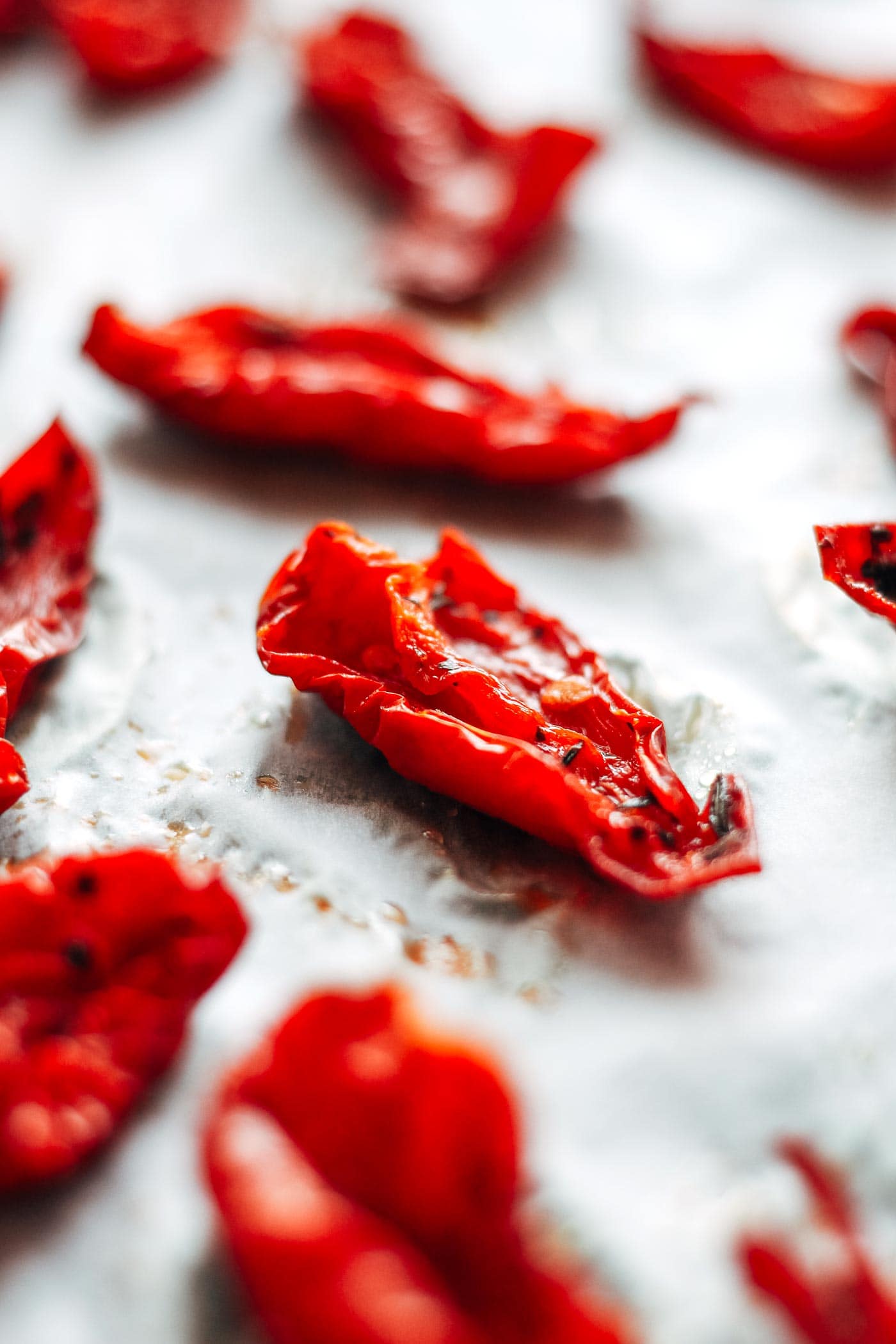
The recipe starts with the tomatoes. Why make your own dried tomatoes? The main reason is to control the amount of salt. For my first tries, I used store-bought sun-dried tomatoes, the kind that is stored in oil. The problem is that store-bought ones are very salty, and since we have to salt the exterior of the cheese for better mold development, it results in an extremely salty, unpleasant flavor.
Making your own dried tomatoes is very easy. You quarter the tomatoes, remove the pulp and seeds, and season with some thyme and oregano. Then bake for 4 hours at 200°F. You can make the dried tomatoes ahead of time. They will keep for up to 6 weeks covered with oil in the refrigerator.
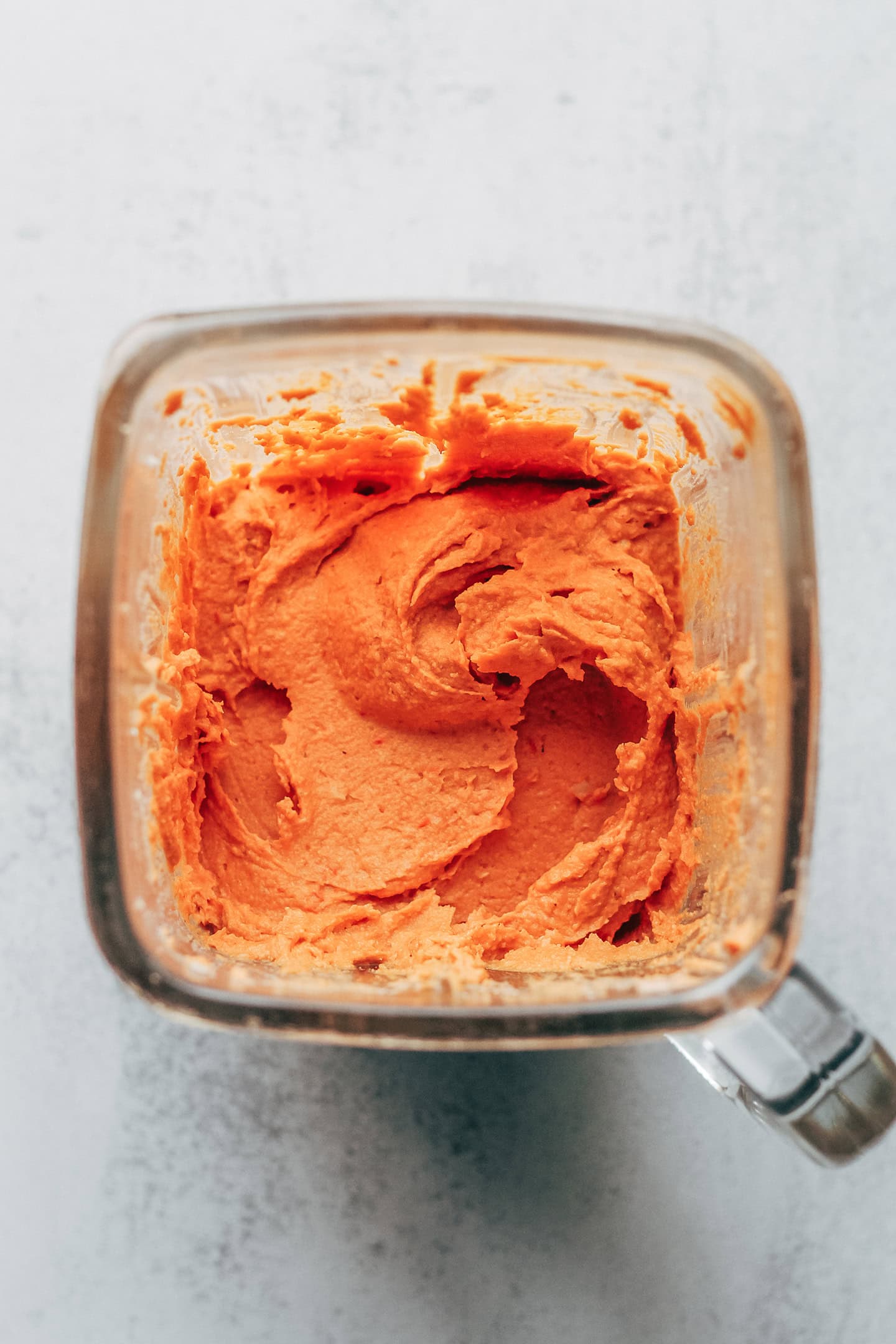
Once your tomatoes are ready, it’s time to prepare the cashew cream. Add the cashews, tomatoes, nutritional yeast, garlic, onion, and water to the bowl of a blender or a food processor and process until smooth. The addition of nutritional yeast is optional but brings more cheesiness.
Next, you stir in the cultures and penicillium, and blend again. 90% of the work is now done!
Finally, fill three springform pans or large cookie cutters with the cashew cream and let it firm up a bit in the refrigerator for 3 days. I usually use metal food rings like these.
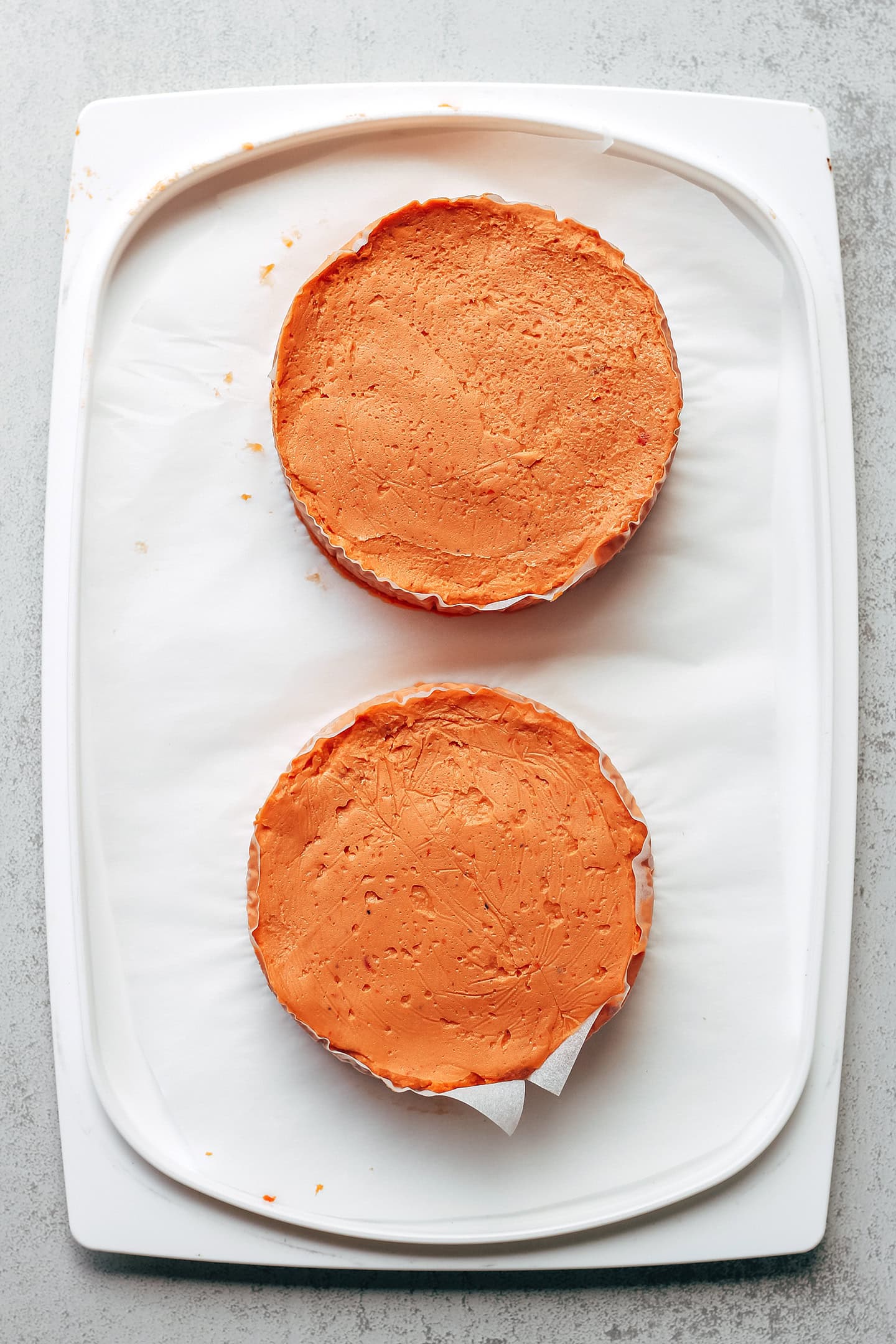
After 3 days, the cheeses will still be very soft. This is totally normal. What you are going to do next is sprinkle salt all over the surface of the cheeses. Salt will do three things: 1) Prevent bad mold from appearing. 2) Boost the development of the white mold, also called penicillium candidum. And 3) Remove excess moisture from the cheeses, making them firmer.
Once your cheeses are salted, it’s all about patience! For the next 2 weeks, you will age the cheeses covered in the refrigerator (or in a room at a temperature of 50-56°F), and flip them every day. You should always keep the cheeses in a container or covered with a bowl or glass. By covering the cheeses, we keep enough moisture to let the white mold grow. If you don’t cover the cheeses, the exterior will dry too quickly, and the mold will never appear.
The aging step will take approximately 3 weeks. It’s ready to eat after around 2 weeks but becomes stronger in flavor after another week. Patience is worth it!

After 10-14 days, your cheeses should be fully covered with the white mold! You can now wrap them in cheese paper and let them age for another week (or two) before eating. The longer you let them age, the stronger the flavor will be.
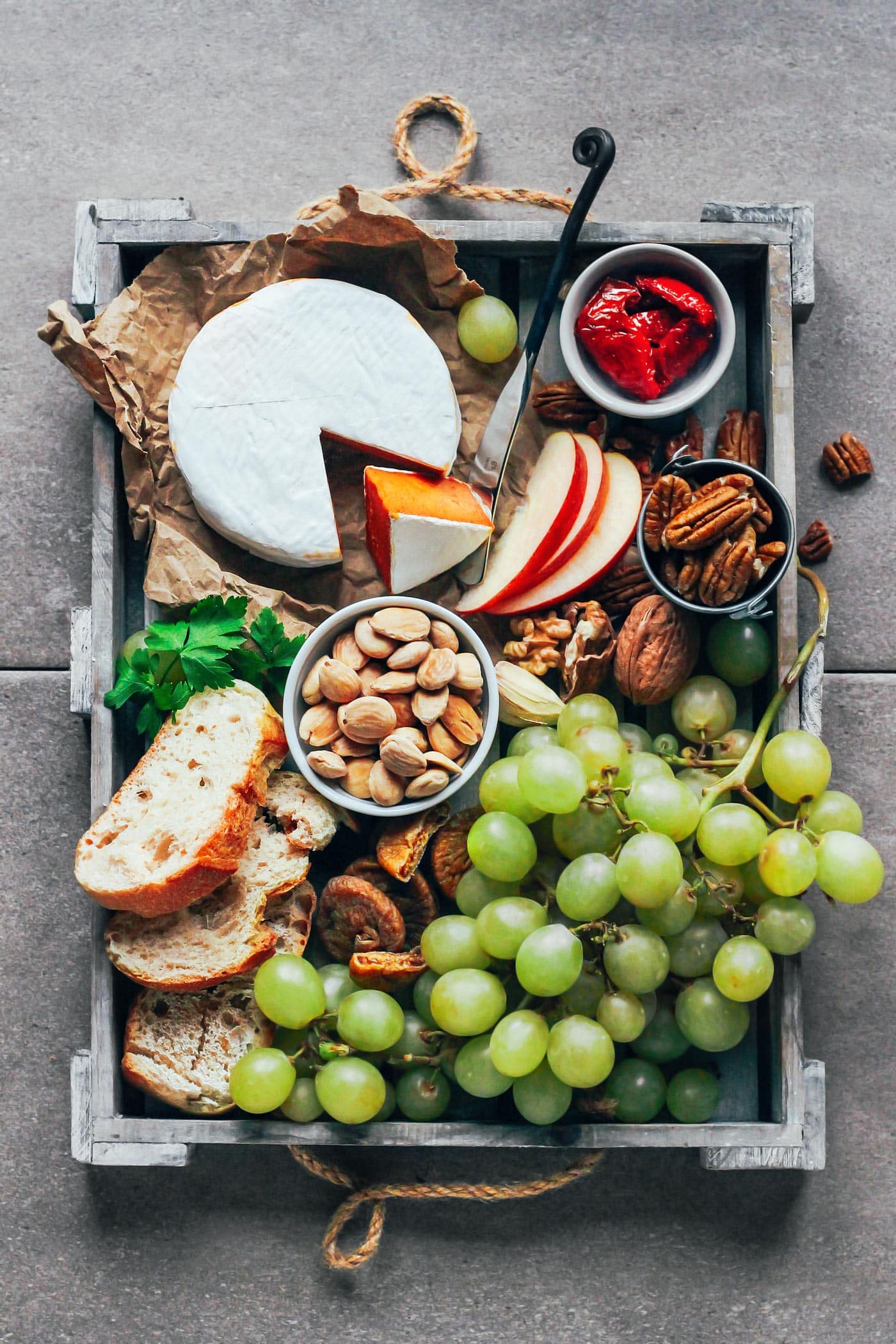
Honestly, have you ever seen a dairy camembert like this?!
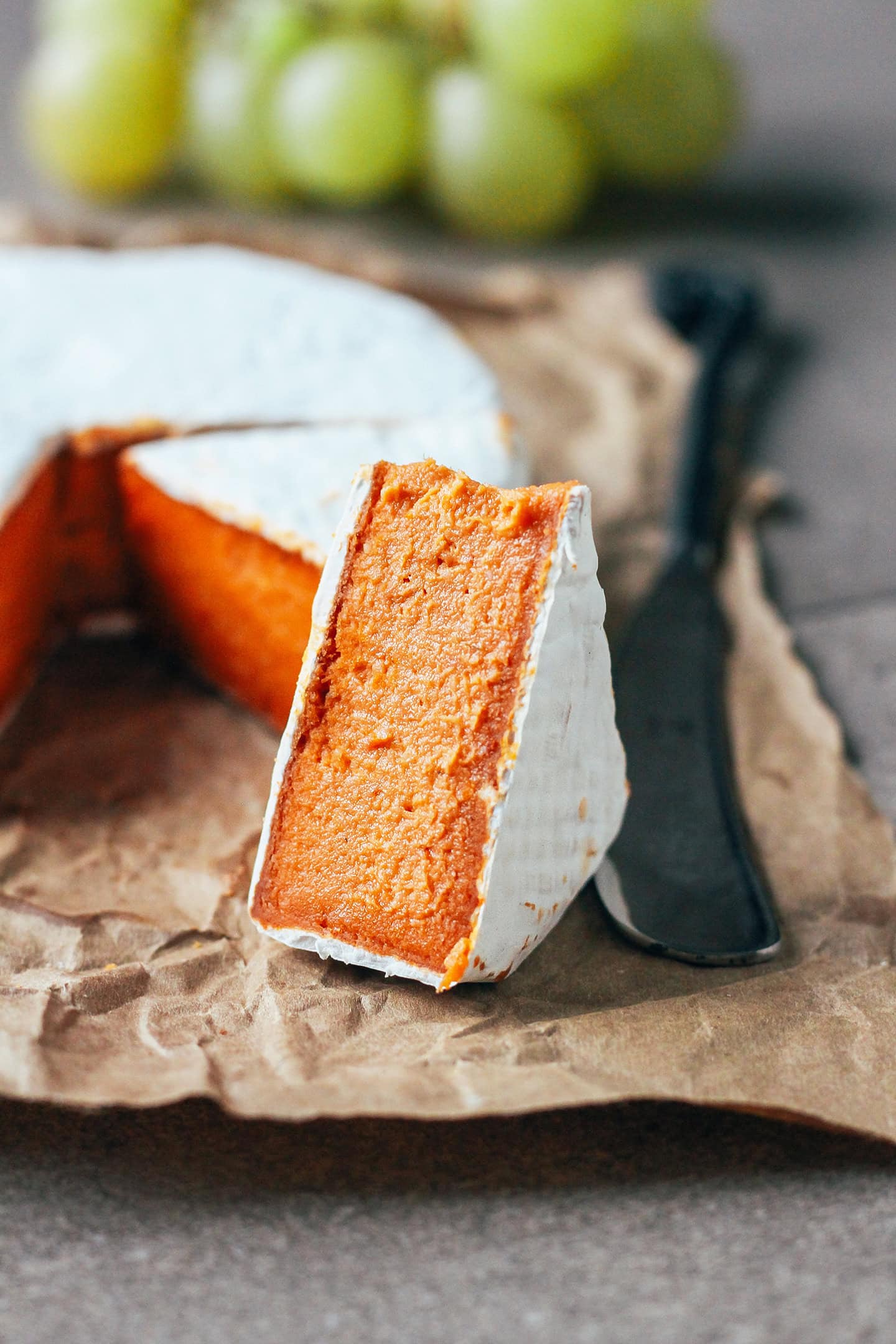
This recipe can be a fun project to do during the holidays, and the result is delicious! We can serve it simply with French bread and/or on a cheese platter with nuts, grapes, and dried fruits. I’m sure a glass of white wine like Chardonnay would go very well too 😉
Let me know in the comments if you try this recipe!
PS: Thanks to everyone who is tagging their cheese creations on Instagram, I love to see your cheeses!
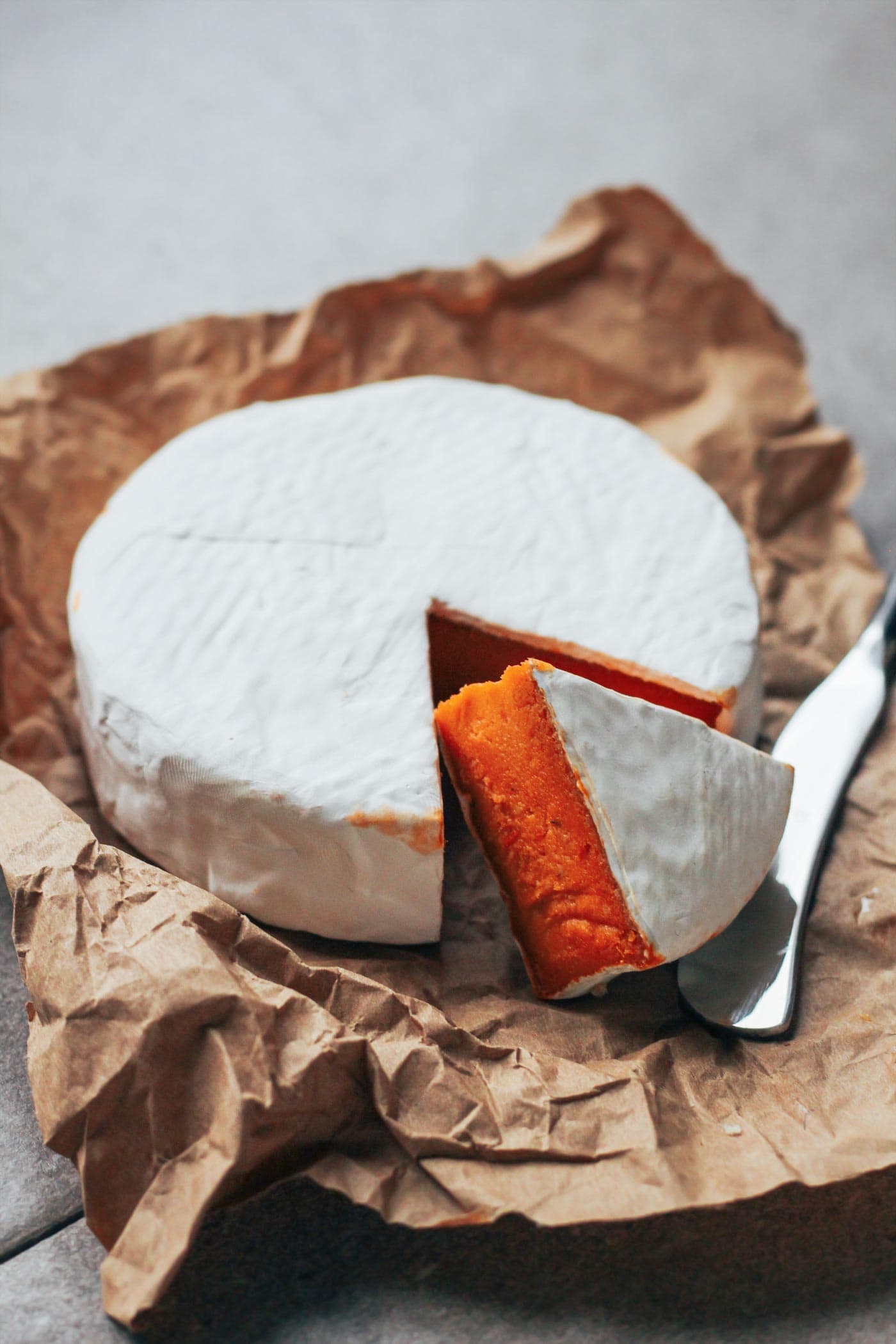
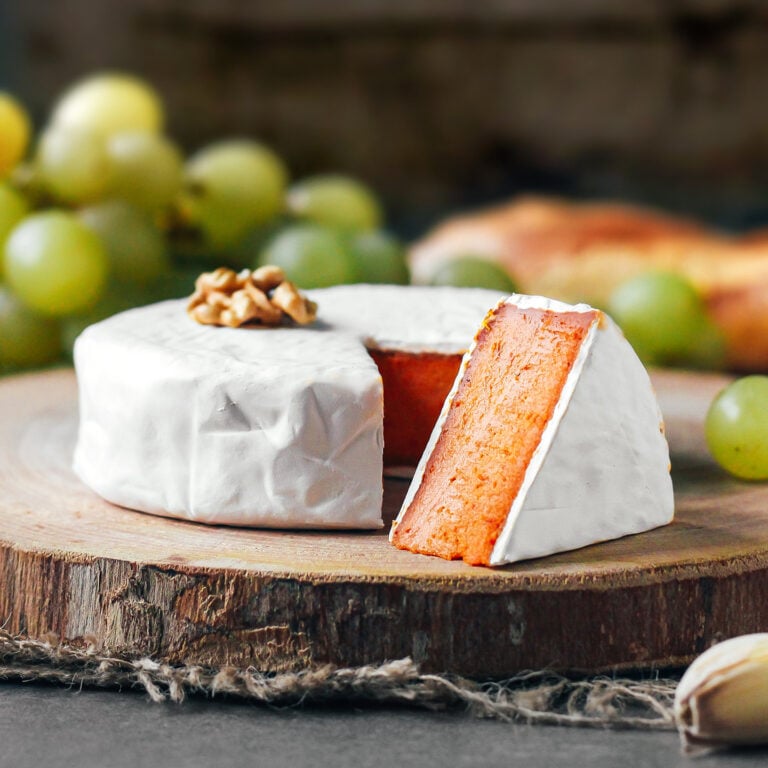
Vegan Sun-Dried Tomato Camembert
Ingredients
Dried Tomatoes
- 10 fresh large tomatoes
- 1 tbsp olive oil
- 1/4 tsp thyme
- 1/4 tsp oregano
- 1/8 tsp salt
Camembert
- 4 cups raw cashews soaked overnight
- 3/4 cup packed dried tomatoes drained
- 1 tbsp nutritional yeast
- 1 and 1/2 tsp garlic powder
- 1 tsp onion powder
- 5 tbsp water
- 6 capsules acidophilus or 1/8 tsp mesophilic culture
- 1/16 tsp penicillium candidum
- sea salt
- optional: 1/4 cup chopped dried tomatoes
Instructions
Dried Tomatoes
- Preheat oven to 200°F (94°C). Line a baking sheet with parchment paper and set aside.
- Rinse the tomatoes under cold water, pat them dry. Cut the tomatoes in quarters and remove the core. Scoop out the seeds and pulp.
- Transfer to a mixing bowl, add the olive oil, thyme, oregano, and salt. Stir to coat.
- Arrange the tomatoes on the baking sheet, cut-side up. Make sure to leave space between each one, you don’t want them to touch each other. Depending on the size of your oven, you might have to use two baking sheets.
- Bake for 4 hours. Remove from the oven and let cool completely. To store: transfer the dried tomatoes to a container and cover with canola or sunflower oil. Dried tomatoes will keep for up to 6 weeks in the refrigerator.
Preparing The Cheeses
- Drain the cashews and place them in a large glass bowl. Bring a large pot of water to a boil. Once boiling, pour the water directly onto the cashews. Let sit 1-2 minutes and drain the cashews again. This step will help kill possible bacterias.
- Place the drained cashews in the bowl of the blender or food processor. Add the dried tomatoes, nutritional yeast, garlic powder, onion powder, and two tablespoons of water.
- Blend on high speed, scraping down the sides from time to time, this step might take about 10 minutes depending on your blender. You want a very smooth, yet thick texture. If needed, add 1 tablespoon of water at a time until smooth. Do not add too much water or the cheeses will be very hard to handle during the aging step.
- Open the probiotic capsules and add the powder to the bowl. You can use mesophilic culture starter instead if you prefer, both will work. Blend for another few seconds.
- Add the penicillium candidum and continue to blend for another 10 seconds. If your penicillium candidum is in liquid form, use about 1/8 tsp.
- Once your mixture is smooth, transfer to a clean bowl. At this step, you can stir in some chopped dried tomato pieces if you want more texture. Cover the bowl with a damp cloth touching the mixture, this will prevent the top from drying. Let the cashew cream ferment at room temperature for 12-36H.
- After about 12 hours, taste the cashew cream. It should have a slightly sour taste, like fresh cream cheese. If it doesn’t and still has a strong cashew flavor, let it sit on the counter for another 12 hours.
- Once cultured, remove the damp cloth and cover with plastic film to touch. Place in the refrigerator for at least 4 hours. Once cold, the cashew cream will be slightly firmer, easier to work with.
- Line a baking sheet, or large flat plate with parchment paper. Place 3 4-inch springform pans on top (without the bottom). I used food rings like these. Cut strips of parchment paper and lay them in the pans to cover the sides, alternatively you can cover the pans with plastic film if you prefer. The goal is to prevent the cheese from touching and sticking to the metal. Fill the pans with the cashew cream and press it down using plastic film so it doesn’t stick to your hands. Make sure the surface is flat.
- Cover each cheese with a glass or plastic container, I used small glass containers but you can also use bowls. This is essential to keep enough humidity and allow the mold to grow. Place the baking sheet in the refrigerator, or in a room at a temperature of 50-56°F (10-13°C). I recommend setting the temperature of your fridge at its highest, around 50°F (10°C).
Aging
- Every day for the next 3 days, carefully flip the cheeses. The cheeses will still be very soft, like cream cheese. This step is the most difficult, but don’t worry they will be easier to work with after a few days. I usually use a plate lined with parchment paper to flip them. You don’t have to leave them in the pans at this step, but it can be helpful to flip them. Always place the cheeses back in the refrigerator after flipping.
- On day 4, sprinkle about 1/4 tsp of salt over the top of the cheese, flip it and sprinkle another 1/4 tsp on the over side. Rub with your finger to distribute the salt evenly on each side and on the sides. Do the same with the other cheeses. Cover the cheeses with the containers and place them back in the refrigerator.
- Continue to flip the cheeses every day for the next two weeks, leaving them covered in the refrigerator all the time. Always use clean hands or work with a plastic film to be sure you are not touching the cheese. The mold will start to appear on day 8-10 depending on the humidity and temperature of your fridge. Once the mold has started to appear, you can transfer the cheeses to a grid or bamboo mat to let the mold grow better (still leaving them in the refrigerator, covered). After another week or so, the cheeses should be fully covered with white mold.
- Once they are completely white, wrap the cheeses in parchment paper or cheese paper and place them in the refrigerator for at least 5 days. The longer you let them age in the refrigerator, the stronger the taste.
- Enjoy with bread, crackers, pesto, nuts, or even jam. The cheese will keep for at least 1 month in the refrigerator.
Notes
Nutrition

About the Author
Thomas Pagot is the founder, photographer, and recipe developer behind Full of Plants. He created the blog in 2016 as a personal cookbook for vegan recipes. Through years of recipe development, Thomas has successfully grown Full of Plants into a trusted resource for plant-based recipes.
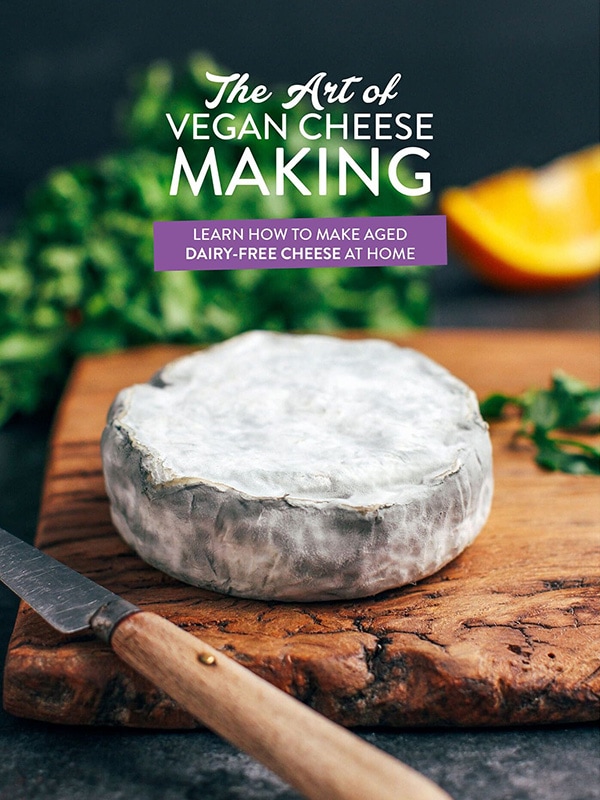
🧀 25 Mind-Blowing Vegan Cheese Recipes!
Sign up for the Full of Plants newsletter and you’ll get new recipes delivered by email weekly, PLUS your FREE 100-page printable eBook!

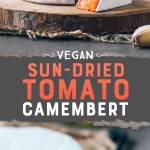


That cheese looks amazing! Can you please tell me where I can buy Penicillium Candidum in North America? The product link in the post is no longer available 🙁
I get my cultures from The Cheese Connection in Seattle, WA. They ship all over the US and are great to work with. Both on the phone and via email, they are very helpful.
http://www.cheeseconnection.net/
I LOVE making Thomas’ cheeses! His genius and generosity are unsurpassed!
Honestly, have you ever seen a dairy camembert like this?!” No we haven’t! This is the logical next step in vegan cheeses I think – using beautiful vegan ingredients (plants) to create something which is conceptually a cheese but is better than the dairy cheeses. These “cheeses” will soon be competing with the dairy cheeses on omnivore’s cheese platters because they are so spectacular and tasty! Go Thomas!
I hope so! Plus, it would be awesome to have more options in stores when it comes to vegan cheese, especially ones made from whole ingredients, not just coconut oil and flavorings.
Glad to hear you like this recipe!
Would you consider starting the trend? I would love to buy your cheeses. This is a very big endeavour AND I have a small fridge… A new business venture for you? There sure is no competition to speak of!
I considered it but then realized I would rather continue working on this blog and experiment/share vegan recipes. There is just more variety, freedom, and creativity involved.
On the other hand, many vegan cheese companies have been created this year, and I’m sure vegan cheese will develop even more in 2018.
Bravo again, Thomas. I am using hazelnuts almost exclusively now, and the ‘hazel’ flavor almost disappears in the culture. Especially with Blue cheese, you get a more complex sharpness, more characteristic of the dairy version. Also it might be valuable to know that anyone can use just a few pine nuts instead of coconut oil, since they contain so much natural oils and develop into a very creamy puree. It seems like you’re now using other ingredients inside the nut base, like sweet miso and other components. Sounds great.
Thanks for sharing Melissa! I definitely have to try blue cheese with hazelnuts soon!
Please stop with pine nuts, you are making me jealous 🙂 I wish I could get as much as you do for a cheap price, but it’s probably the most expensive nut here.
Regarding the other ingredients, I try to use as less as I can for cheeses but in this specific recipe, miso, garlic, and nutritional yeast gives it more complex flavors that pair well with the sundried tomatoes. Thanks for the rating!
Another great innovative recipe! Congratulations! The cheese looks so deliciuos. Thank you so much Thomas for sharing your discoveries!
Thanks Madhuja! 😉
Hi Thomas,
like the idea! My husband immediately liked the recipe too. Such an amazing idea!
Thank you so much for sharing all these great recipes!
You’re welcome Katja!
You’ve done it again Thomas! I can’t wait to try this. Great work!!!
Thank you Kat!
It looks such delicious. Thanks for sharing the recipes and the fantastic pictures!
You’re welcome Mia!
This looks great! Your cheese recipes have inspired me to start making my own cheeses- my sister has promised me a cashewbert kit for christmas and I can’t wait!
Some questions though: have you tried to do anything with transglutaminase yet? And what do you think about adding lactic acid for flavour?
Thanks for all your hard work 🙂
Awesome! Cashewbert has great products!
Yes I tried using translutaminase several times, the results were very good. The rind grows fast, the only downside I found is that the texture is not as rich as cashew-based cheeses, and they turn more acidic very quickly. Meaning you can’t keep them for a month in the refrigerator or they will be too sharp/piquant.
I don’t really use lactic acid, I don’t see the point of using it if you are already using mesophilic or acidophilus cultures. It can be useful if you make quick cheesy sauces that don’t require fermentation.
Hi Thomas! Is the Penicillium Candidum integral to the recipe- helping preserve the cheese and such? I’m on a budget and wondering if I can leave it out. Thanks in advance!
Hi Ursula! Penicillium Candidum is a key element in this recipe, without it you won’t get the camembert flavor or even the white rind.
Thanks so much!
Hi Thomas,
My Sundried camembert should be ready in a week, however there are only a few random spots of mould on the outside. I’m not sure why, although I live in Australia and maybe the cheese got too warm/hot during the ‘fermenting’ period – I have no idea. I’m following the recipe exactly, maturing the cheese in the fridge, so this is all I can think is the problem. Are there any remedies and is it ok to eat the cheese if it hasn’t ‘moulded up’ in this way?
Many thanks again – I really appreciate your expertise and generosity.
I’m astonished. Your cheese looks absolutely fantastic and sooo tasty.
I love cheese and I went veggie only 3 weeks ago… currently trying to make this journey creative and funny.
I absolutely wanna try your cheese, I will give you your fully earned credit when the big day will come.
Thank you so much for sharing.
You do a wonderful job with your experiments. Great!
Awesome! Thanks for the kind words Penny 😉
I just started the fermenting process today. I just found out I have to leave town for 2 days. I will be @ the start to flip daily after salting process. Will these be ok to sit for two days without flipping?? Or am I going to mess them up completely. 🙁
Hi Tara,
Sorry for the late reply, I guess it’s a bit too late now 🙂
Yes it’s okay if you don’t flip them for 2-3 days, especially at the beginning since the mold hasn’t started to grow yet.
Hi Thomas! Thanks for replying. I got home lastnight (3 days after salting) and the mold has started to grow!! It all looked good. Today when I flipped the mold has some orange-pink tint to it. Could it just be from the paper having some of the sundried tomato color?? Should I remove it? Change the paper? Start over? Or am I ok?? They smell lovely! I am so excited!!
Hi Tara,
That’s great news! Regarding the orange-pink mold do no worry about it 🙂 Its definitely the sundried tomatoes that can color the mold, especially if you haven’t flipped the cheeses for a few days. If you have one, you can now place the cheeses on a clean grid (that fits in your aging container/box as you always want the cheeses to be covered), or simply place the cheeses on chopsticks. Doing this will make the mold grow faster as there will be more surface in contact with air. If you don’t have any grid then make sure to flip the cheeses every day so the mold grows uniformly.
Hope you will like this cheese!
Hi! This is really great!!!! I was wondering if you have suggestions on how to make cashew cheese that is solid without using agar-agar or waiting three weeks?
Hi Anna,
I think you should check out cheeses made using tapioca starch or carrageenan. Personally, I prefer real aged cheeses 🙂
Hello Thomas,
Excellent recipes excellent blog, please add more recipes.
You are very precise and I like it.
I am vegetarian but interested with vegan recipes.
I like to do mimetic cooking and imitate meat and cheese, without meat and cheese of course.
Best regards.
Demy 🙂
Hi Demian,
Thanks for the kind words! 🙂
I just tried mine today, I think I need to add more salt but overall it is really good! Thank you so much Thomas ,it was so surprisingly easy to make! I will be starting a new batch tomorrow, I was thinking of may be adding roasted red pepper inside, will be interesting to see if that will work nice 🙂 the blue cheese is maturing in the fridge as well, excited to see how that would turn up 🙂
Awesome! So glad it turned out great for you! Thanks for your feedback 🙂
Looks so delicious and Pure comfort food for sure!
This cheese looks so beautiful. I tried to make it exactly according to the recipe, but the mold would not grow. It did with other cheeses though…………….so the culture was ok. Maybe there was too much acid in the mixture?? Some tomatoes are more acidic than others……… But same thing with the ash-ripened cheese….the white mold had problems growing through. Do you have experience with that problem? And maybe a solution on hand? I would love to give it another try.
I would recommend checking the FAQ in my ebook. Most probably it’s a problem of moisture or temperature.
HI Thomas…………..moisture and temperature were exactly the same in which my plain cashew-brie developed a wonderful white mold.
Omg this looks great but I’m allergic to cashew (my issue with a lot of vegan cheeses) could macadamia nuts be substitute?
I have never tried using other nuts, sorry!
Hi Thomas,
I took my cheese mixture out today to put in the moulds and there was white mould growing on top of the cheese under the cling film I had pressed onto the top of the cheese to stop it drying out. I see you say the mould should not appear until around day seven, so I am worrying that my cheese has gone wrong. I did not have a small enough spoon to measure out one eighth of a tea spoon of the penicillium candidum so may have put more in that required. The mould was white. I scraped it off and discarded it.
If you could help me with some advice I would be very grateful,
Regards
Ruth
Hi Ruth,
Don’t worry too much about it, white mold is usually not bad mold. So if you scraped it off you should be good, continue the process.
Hi again Thomas,
Just turned my cheeses over and white mould is starting to grow already only a day after making the cheese moulds. Do you think it is ok? Thank you for your time, I appreciate it.
Regards
Ruth
Hi Ruth,
One day seems very, very quick. I doubt what you are seing is penicillium candidum. Scrape it off and resalt the area.
Hi Thomas,
I think I miss read your quantity for the candidum I used double what I should have, so that must have been why the mould grew so quickly. My cheese is now covered with white mould and on track for being ready in a couple of weeks.
Thank you Thomas for your help
Hi Ruth,
I doubt using X2 the amount of penicillium causes the mold to grow that much faster. It shouldn’t cause any problem though.
Hi Thomas, have you experimented with harder cheeses like cheddar or dubliner yet? After seeing your recipes for camembert and blue cheese I feel like anything is possible.
Hi Robert,
I did but unfortunately didn’t get good results, even after months of aging.
Is there a way to dry the tomatoes in an air fryer?
I do not own an air fryer and never used one so I’m afraid I have no idea if that is possible, sorry.
Hi Thomas,
I was wondering, can I use cherry tomatoes instead of large tomatoes? Drying large tomatoes takes so long… And if so, how many tomatoes do I put in the cheese? Something like 500 grams?
I hope to hear from you! Thanks in advance!
Hi Ida,
Yes that will work with cherry tomatoes as well! It will be a little bit shorter to dry them, but not that much less.
Regarding the amount, I am not very sure. I would say about 800g of fresh cherry tomatoes.
Your vegan cheeses look delicious!
But I’m writing out of concern that your suggestion to raise refrigerator temperatures to 50°F could raise the likelihood of people getting food-borne illnesses from other foods in the same fridge (such as Bacillus Cereus growing in cooked rice). In the US, government food safety advice is rather adamant that we should be keeping the majority of our refrigerated foods at a temperature lower than 40°F.
Thanks Claire!
Personally, I have used my main fridge with a temperature of 50°F in the past to make vegan cheese and never had any issues. I still recommend using a separate fridge (or wine fridge) for cheese-making, though.
HELP! You are a genius with food, first of all. But I screwed up and need help :S
I was making this cheese tonight and accidentally grabbed penicillium Roq. not P candidum. Should I add the P candidum? or am I going to end up with a tomato blue cheese? How would I handle it differently? Thank you for your amazing vegan cheeses book, it has been a treasure.
Thanks Connie 😉
You will end up with a tomato blue cheese I’m afraid. Adding P. candidum would just result in a mix of molds (you would get some white patches as well as blue ones).
I would simply try aging it as normal, knowing it won’t be a camembert 🙂